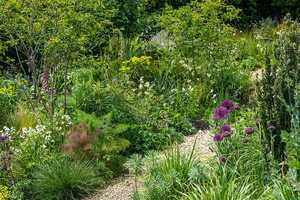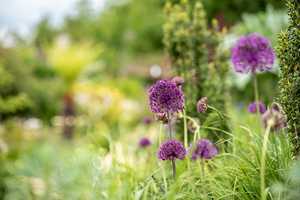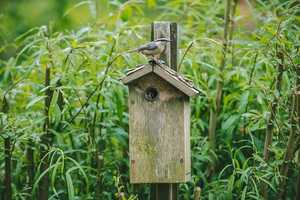Pollinators and wildlife in a beautiful garden by Sarah Jarman
A few years ago on a family campervan tour of the Netherlands I was lucky to be able to visit Piet Oudolf’s garden at Hummelo.
The garden was breath taking in the height of it’s summer beauty, but something I was not expecting was the constant vibrant hum and buzz of pollinators visiting and inhabiting the garden. It filled my senses and heart with a sense of awe and wonder and made me realise that beautiful gardens should also provide habitats and ‘service stations’ for wildlife. In a world with a changing climate and more and more pressures on the use of land from human development, we can make a huge difference in our gardens united with the desire to create a beautiful space outside. The two can and should always be combined to create a haven for ourselves and nature.
There are things to plant and simple modifications and additions to your plot, however small or large that can be made to enhance the ecology of the site and the habitats your garden offers, without impeding its beauty or costing the earth.
There are over 250 species of bee in the UK by ensuring that we have a long season of flowering interest from the earliest Hellebores in January to late summer and autumn flowering herbaceous perennial favourites such as (Sedum) Hylotelephium telephium we give pollinators the best opportunities. Don’t let the long Latin names put you off – a quick internet search and you will be able to find them. Also the flowering season can be lengthened and enhanced with bulbs; watching the bees on the Alliums in the Sitting Spiritually garden this summer was a highlight of the open days. Butterflies have their own preferences such as Buddlieija and planting evening primrose or Oenothera biennis, tobacco plants, Nicotiana affinis will attract night pollinators such as moths and these in turn will attract bats.
Bat and bird boxes can provide nesting and roosting sites. We are planning to install Swift boxes on two of our garden projects this year. One in Lyme Regis where a barn in the locality is being re-developed into a modern home on a neighbouring property. The returning swifts will hopefully be able to relocate to a new home which will be installed on our client’s nearby cottage, so that they can continue their stay and raise their fledglings to dip and swoop over the rare cliff top meadow.
Considering our direct impact on wildlife in terms of boundary choices and its construction will offer new possibilities and help curb the possible extinction of one of our dearest mammals. Hedgehogs have declined by 30 % in the past 10 years in the UK and their numbers are now thought to be under 1 milion. Avoid using slug pellets and chemicals that poison them and create spaces where they can come and go by opening up our gardens and welcome them back into their lost habitats. Hedgehog highways are now being created between gardens in suburban and urban fenced areas to allow free movement and roaming for these wild animals between properties. Making a 13cm access point at the bottom of one of your fence panels or replacing one of your gravel boards with a hedgehog access gravel board will greatly improve the chances for these adorable creatures who feast on slugs and snails and are a gardener’s friend. Fencing suppliers Jacksons now offer such products as do many other companies.
There are many publications that recommend native plants, trees and shrubs to add to your garden, Chris Baines has written a colourful handbook ‘Companion to Wildlife Gardening’ published by the RHS which I would recommend to further your reading in all areas and to inspire the development of your garden and your experience of the wildlife within it.



All the photos were taken in The Sitting Spiritually Garden, which is open to visit throughout the Winter months, please just call first to check someone is there: 01297 443084
With many thanks to Sarah Jarman & Anna Murphy
sarah jarman +44 7872 972259
anna murphy +44 7812 086104
If you would like to contribute a blog, please contact Sitting Spiritually at info@sittingspiritually.co.uk
Posted on January 14th 2020
